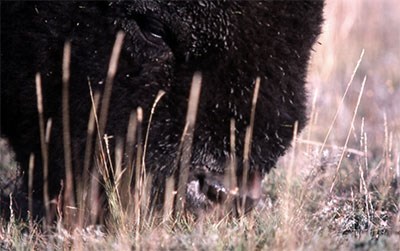Last updated: November 6, 2017
Article
Bison Bellows: Bison Eating Habits Influence the Prairie Ecosystem

NPS Photo/ J. Schmidt
Just like cows and elk, bison have four stomachs. While you may think this means that bison can eat four times as much as animals with one stomach, this is not the case. Their four-chambered, ruminant digestive system allows for the absorption of cellulose- a fibrous plant material that is hard to breakdown. With this ability to digest cellulose and their selective grazing habits, one of bison's greatest influences to the prairie ecosystem is based on their foraging ecology.
Bison are considered generalist foragers, meaning they eat a wide array of herbaceous grasses and sedges commonly found in mixed-grassed prairies. These types of plants include species such as Blue gramma, sand dropseed, and little bluestem. Although bison graze heavily on grass species, they will occasionally consume woody vegetation when food is limited. By feeding mostly on grass species and selectively avoiding other plants, bison influence the local prairie biodiversity. In other words, bison create a spatial mosaic pattern of grazed and ungrazed areas. If you imagine a quilt with patches each representing different plant species and sections of grazed and ungrazed areas, this "quilt" can often exemplify an area after a bison herd forages. With high plant biodiversity, there can be an increase in gas exchange, biomass, and plant cover. Photosynthesis also increases when bison selectively graze, because with many different kinds of plants, there is increased light availability and reduced competition for water and nutrients.
Bison are also attracted to recently burned areas, therefore, influencing plant diversity. After a disturbance, such as a wildfire, grasses establish before other plant species. Bison prefer these regrowth areas because they have a plethora of grasses available to them without having to graze selectively around woody plant species---woody plants take longer to establish after a disturbance. By grazing in these new grass-dominated sites, bison help increase the local diversity. In other words, a variety of plants have the chance to grow in grazed and burned areas.
Undoubtedly, bison grazing patterns influence the prairie ecosystem. Their foraging is important for plant community structures, because woody vegetation can flourish in a grass-dominated landscape. Selective grazing by bison can result in a diverse, heterogeneous landscape of plant species. This preference of grass species can help reduce competition for resources between grasses and woody plant species, certainly increasing species richness and diversity found in the prairie ecosystems.
